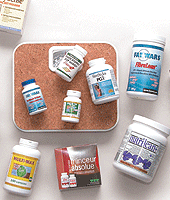Tip the Scales in Your Favour
Tis the season for dieting. January awakens our resolve to lose spare tires, saddlebags, and other jiggly bits. For every plump little pound we want to lose, we must eliminate or burn 3,500 calories.

'Tis the season for dieting. January awakens our resolve to lose spare tires, saddlebags, and other jiggly bits. For every plump little pound we want to lose, we must eliminate or burn 3,500 calories. It's a simple formula, but it's not always easy to stick to a weight-loss plan.
The hardest part of dieting is when food cravings sabotage our resolve. Instead of driving to the nearest source of fattening junk food, power walk or cycle to your local health food store where you'll find a selection of delicious, high-nutrient, low-calorie foods, along with safe weight-loss support products. Here's a handy shopping list of supplements, herbs, and foods to help tip the scales in your favour.
Weight-Loss Support Supplements
Protein powders: These supplements can ensure adequate protein requirements are met without adding too many calories, carbs, or fat. Primarily derived from whey protein concentrates and isolates, or from vegetable soy, protein powders supply a convenient, low-calorie source of readily assimilated protein. For example, a blended protein shake made simply with a scoop of whey protein powder, filtered water, and fresh or frozen berries will supply an average of 20 grams of protein, with less than 100 calories, two grams of carbs, and a gram of fat. This kind of protein shake is an ideal snack replacement for a low-calorie dieter because it satisfies the appetite, encourages fat-burning, and builds lean tissue. Other protein powder sources include fermented soy, rice, pea, and hemp. (Avoid protein powders and bars that contain gelatin or collagen, as they often contain bones, hooves, and skins of cattle and pigs.)
Fat burners: Conjugated linoleic acid (CLA) has been found to assist in the loss of body fat when taken in doses ranging from 1,800 to 4,200 milligrams daily. Drinking green tea and taking epigallocatechin gallate (EGCG), an extract of green tea, supports fat loss by increasing energy expenditure.
Appetite and craving controllers: The amino acid 5-Hydroxytryptophan (5-HTP) has been shown in three controlled trials to reduce appetite and promote weight loss. Overweight women and obese people with diabetes who took 750 mg per day for two weeks significantly reduced their carbohydrate and fat intake and lost an average of 4.6 pounds, compared with 0.2 pounds in the placebo group. In a two-month controlled study, niacin-bound chromium, 400 mcg a day, caused a significant loss of fat while sparing muscle in dieting, exercising women.
Multiple vitamin and mineral supplements: Taking a high-quality complete multiple vitamin and mineral supplement is a simple, economical way to ensure that daily micronutrient requirements are met.
Fat-Fighting Foods
Leafy greens: High-fibre, low-calorie, and nutrient-dense leafy green vegetables (arugula, spinach, kale, Swiss chard) fill you up without filling you out. They also delay sugar release to the bloodstream. According to the American Journal of Clinical Nutrition (1999), people who eat the widest variety of vegetables have the least amount of body fat.
Lean proteins: These proteins (skinless chicken and turkey breasts, fish, egg whites) help build lean muscle mass. The more lean muscle the more calories burned. Protein foods tend to satisfy the appetite and reduce cravings for refined carbohydrates. Choose organic, free-range, or wild sources whenever possible.
Fruits: Mother Nature's sweet, low-calorie fast-food fix, fruits (especially apples and berries) are a great source of fibre, vitamin C, and folate.
Vegetable sticks: Turn to crunchy vegetables (carrots, celery, red and green bell peppers) when a snack attack hits, instead of munching on high-calorie, low-nutrient potato chips. Fresh, raw veggie sticks are loaded with appetite-suppressing fibre and nourishing vitamins, minerals, and phytonutrients.
Whole grains: There's a lot of appetite-satisfying fibre in whole grains (brown rice, barley, buckwheat, bulgur, millet, oats), as well as B vitamins that help metabolize fats.
Beans and legumes: The darling of the dedicated fat fighter, beans (soybeans, lentils, green peas, yellow peas, chickpeas, kidney beans, black beans, pinto beans) are low fat but loaded with nutrients, protein, fibre, and complex carbohydrates. They're also a versatile and delicious alternative to animal-source proteins.
Nuts and seeds : Ideally eaten raw, nuts and seeds (almonds, walnuts, filberts, pecans, flax, sunflower, sesame) are loaded with the right kinds of essential fats, complex carbohydrates, fibre, lignins, and protein. Just a tablespoon can satisfy hunger, stabilize blood sugar, and give quick energy.
Oils: Healthier sources of fat (olive, grape seed, flax, and hemp oils) support heart health and metabolic function.
Yogourt: As topping for fruit, porridge, or vegetables, low-fat yogourt is a good source of protein and calcium. Forget the flavoured yogourts, though they're usually loaded with sugar.
Condiments and Spices: Low in fat but high in flavour, condiments and spices (horseradish, chili sauce, lemon and lime juice, mustard, pickles, vinegar, salsa, ginger, cayenne pepper) will help retrain your taste buds away from high-calorie mayonnaise, butter, and creamy sauces.




